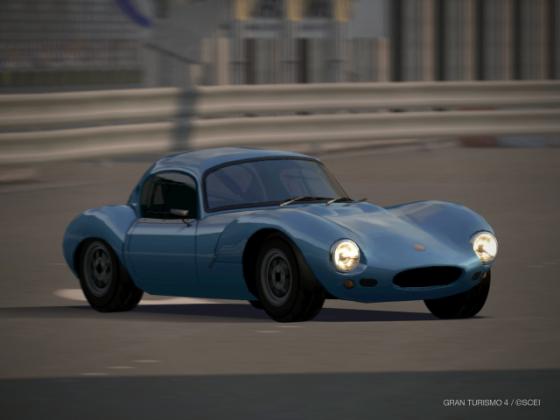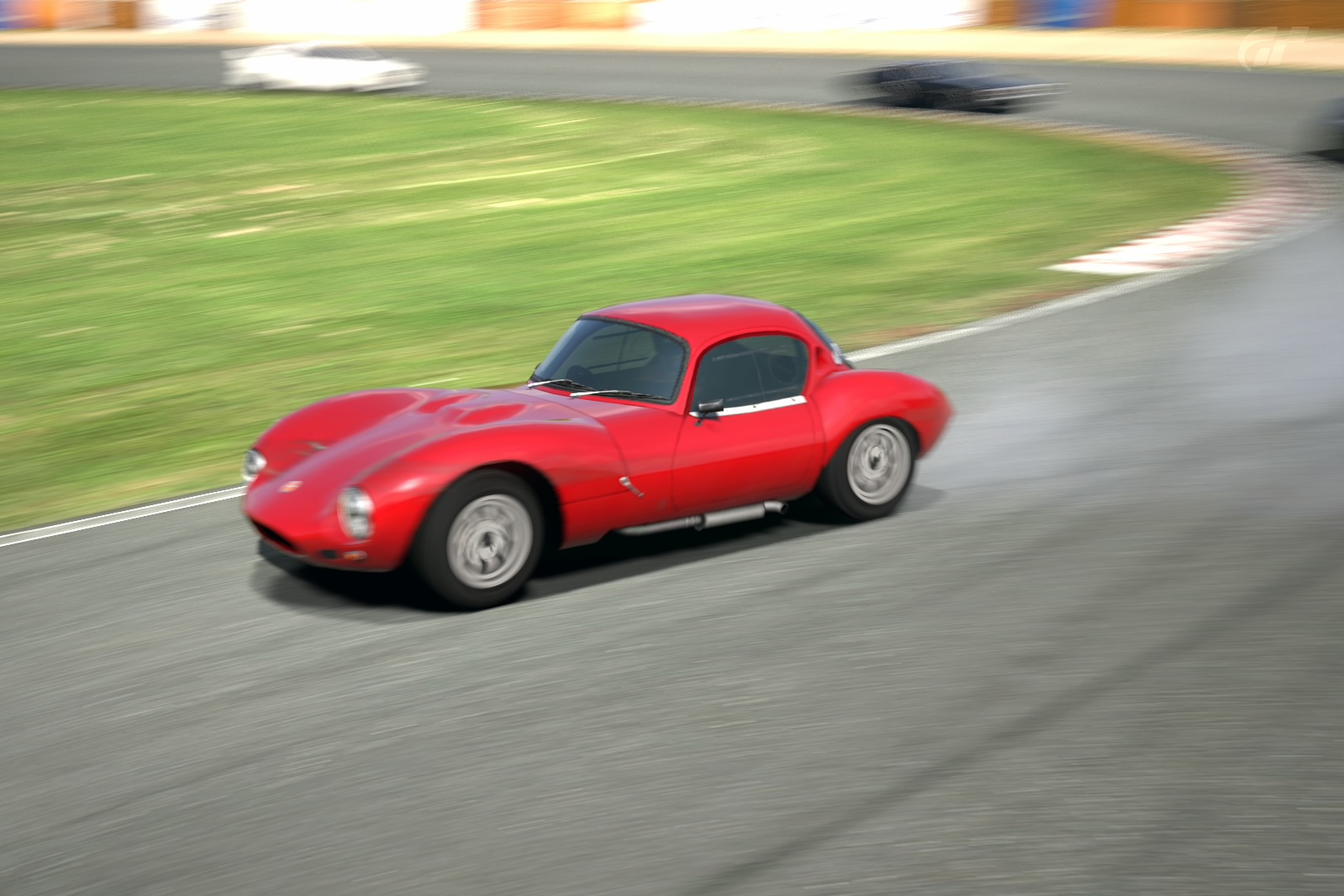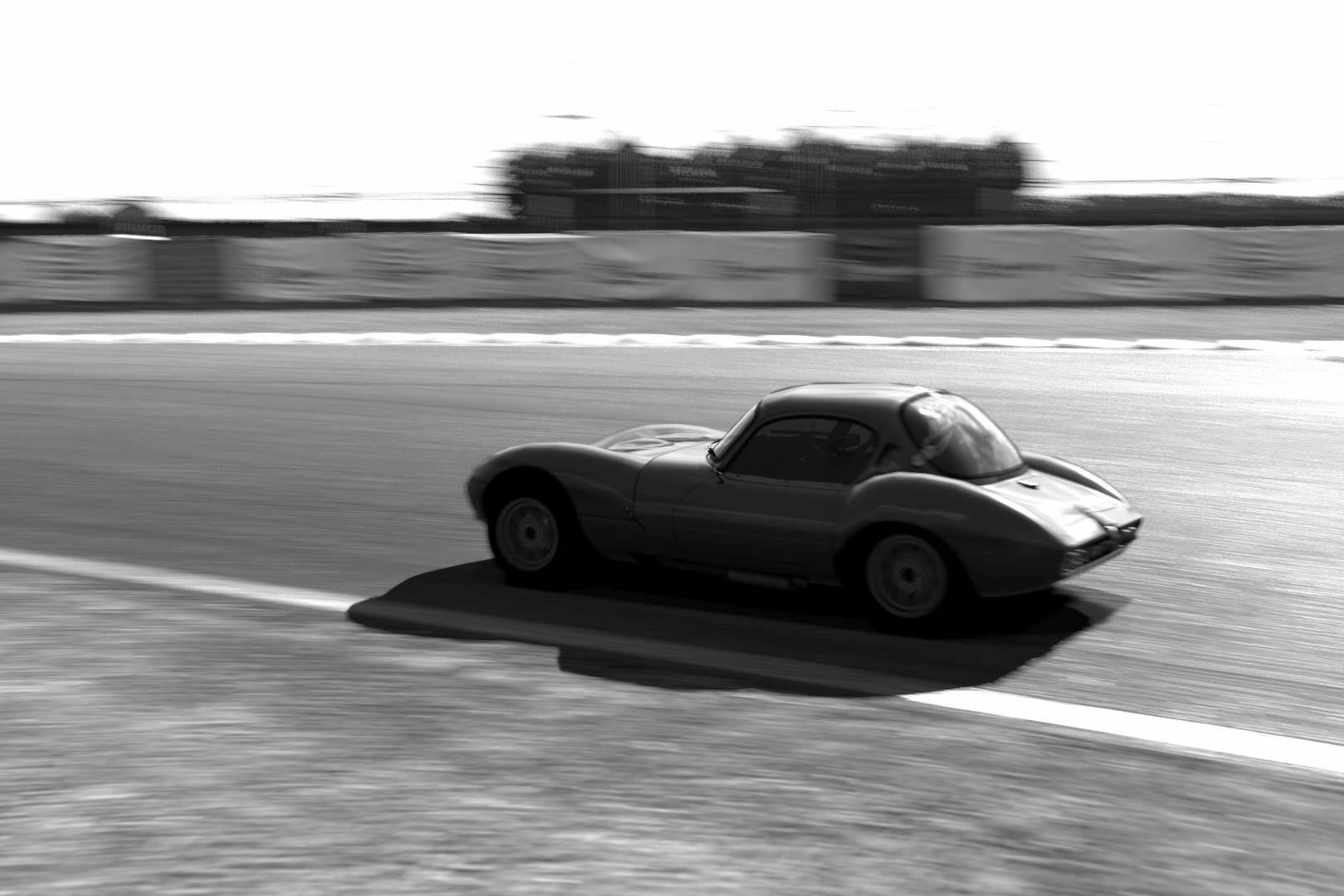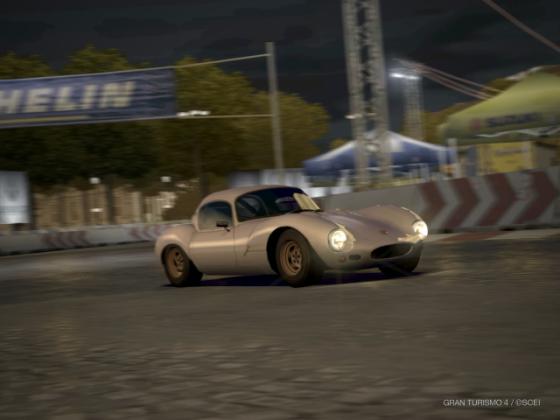SPECS
Year Represented: 1964
Class: Sports Car
Type: Coupe
Country: England
Host: GT4 & GT5
Price: GT4: Prize car.
GT5: $47,281 (used car lot)
GT5
Mileage: 1,872.5
Length: 132.0" // Width: 56.0" // Height: 42.0"
Wheelbase: 80.5"
Overhang: @ 4 feet 5 inches
Track: 46.0" front
& rear
Ground Clearance: 4.7"
Construction: fiberglass body w/ Perspex side & rear windows. steel tube-frame.
Weight:
1,001 pounds
Steering: unassisted rack & pinion
Layout: Front Engine / Rear Drive
Tires: 185/60-13
F. Suspension: double
wishbones, coils, anti-roll bar, shox
R. Suspension: live axle, upper trailing arms, coils, shox
Brakes: disc/drum
For
all specs & testing, the car in GT5 was not given oil change or engine rebuild, since its tested power was slightly above
dealer-quoted power (90 vs. 89). However, the GT4 Ginetta starts with 5 extra horses as a zero-mileage car, resulting
in slightly faster results.
Engine: 1.5 liter OHV inline-4
Aspiration: normal
Fuel System: ?
Valves / Cyl: 2
Bore x Stroke: 3.19 x 2.80"
Compression: 9.0:1
Tested HP
GT4: 95 @ 6,000 rpm
GT5: 90 @ 6,000
Fnl.
Torque
GT4: 100 @ 4,500 rpm
GT5: 95 @ 4,500
Credits per HP: ? (GT4), $525.34 (GT5)
Lbs. per HP: 10.54 (GT5), 11.12 (GT5)
Hp per Liter: 63.5 (GT4), 60.1
(GT5)
Idle speed: 1,000 rpm (GT4), 750 (GT5)
Redline: 7,000 (GT4 and GT5)
RPM Limit: 7,500 (both games)
Transmission: 5-speed manual
Differential: ?
0-60 mph:
GT4: 9.283 seconds
GT5: 9.785
0-100mph:
GT4: 23.716 seconds
GT5: N/A
400 M:
GT4: 17.296 @ 86 mph
GT5: 17.723 @ 83 mph
1
KM:
GT4: 30.726 @ 112 mph
GT5: 31.441 @ 109 mph
Brakes 100-zero mph: 5.48 seconds (GT4), 5.617 (GT5)
GT4 Test Track: 2:45.578
GT5 Daytona Lap: 1:10.133
Top
Gear RPM @ 60 mph: 2,900 (GT4), 3,100 (GT5)
GT4 Top Speed at Redline
1st: 32 mph
2nd: 62 mph
3rd: 91 mph
4th: 115 mph
5th: 142.1 mph
@ 7,250 rpm
GT5 Top Speed at Redline
1st: 31.4 mph @ 7,000
2nd: 60.7
3rd: 88.1
4th: 111.1
5th: 138.8 @ 7,200 rpm (rpm approximated)

------------------EXTERIOR / HISTORY--------------
When I was a young lad, my father sat me upon his knee...to tell me all he knew about
cars.
...Uh wait a minute. Cause that aint the way it happened at all! Let me start over.
Yeah, like my father would ever sit me upon his knee (and for this I am grateful)...he'd just
as soon hock one in his beer! But that just sounded like a good way to start this review, something a great novelist
(a real writer) like Salinger would say. Anyways.
I was a kid of the '70s. Lucky Me. This was a time during which (in America) we were quickly getting
trounced in the automotive market for various reasons. It was during this time I'd often hear my dad & his buddies
discussing cars. One of my dad's best friends (whom I'll call "Charlie", since that was his name) had an MGB or an MG Midget--I
forget which. It was during these discussions that I surely formed an early opinion: little European sports cars were
of greater value from a driver's perspective than larger sporty Americans such as the Pontiac Firebird/Trans Am, Ford Mustang,
and Dodge Charger.
But I was a kid. I never actually got to drive till I was 13, not that my parents ever
knew about this; they were away on vacation at the time! Anyways, is there any truth to what I picked up from
my elders? Did Europe really always produce the better sports cars than America?
Let's discuss the Ginetta G4 now. Awarded as a prize after winning the Lightweight Car Series in Gran Turismo
4, or dredged out of GT5's used car lot, the Ginetta is the latest on my "Cars I Never Heard Of" list. Many of us
have our own "Cars I Never Heard Of" (CINHO) list...these being cars which we've never heard of before playing Gran
Turismo. My CINHO list includes TVRs, Nissan Skylines, Pagani Zondas, and SilEighties, among many others. When I first
noticed the '64 Ginetta G4, probably during the 1000 Miles! events, I added it to my personal CINHO list and assumed:
1. This was Ginetta's only model.
2. In real-life, the Ginetta G4 was produced in low numbers before the factory folded, or was absorbed into
British Leyland.
3. Ginetta is no longer around.
....So I looked at the small, sexy Ginetta G4 I'd never heard of with a touch of nostalgia, sniffing
back a single tear. After racing one, and doing my usual research, I was pleasantly surprised to find that not only was
the G4 just one of Ginetta's models, but the company thrives to this day! In fact, Ginetta has split off; a second company
started in the early '90s called DARE produces cars similar to Ginettas. Ginetta was originally started by four brothers....DARE
is two of the four brothers + one of their sons I believe.
In truth, there are a great number of low-volume carmakers in Great Britain. Bristol, TVR, Caterham, Morgan....Ginetta
is just one out of dozens we can add to our CINHO list, and has been in business since 1958.
Ginetta's first efforts were actually kit cars, strictly for racing. The G4 first appeared in 1961 or 1962
as a convertible, and was their first road car, tho it could be (and was) often a decent racing machine as well. The
G4 series II is the coupe version. The only difference between the G4 and the G4 series II is one is a convertible, the other
has a solid top.
Since G4s are fiberglass vehicles with nothing but a tube-frame and some thin sheetmetal underlying, they
are extremely lightweight. At 1,001 pounds, the Ginetta G4 is one of the lightest cars any Gran
Turismo game, period. There are very few autos (such as the Subaru 360) claiming less pounds. Bad if you get
in an accident, good if you happen to be on a race track in real-life or GT4.
...assuming you can handle it!

---------------ENGINE / DRIVETRAIN-----------
Like in many British sports cars, the 1.5 liter straight 4 in the G4 was plucked from
somewhere else; in this case from the Ford Cortina, a popular passenger car that also made appearances in rally racing. A
bit low on torque, there's not too much I have to say about this powerplant. In a car weighing 2,000 pounds, we might
have some problems, but it can do some damage in a car weighing half this amount.
Revs must be kept highish
most of the time. Peak power is at 6,000, and redline is at 7K, which means there's lots of revs to exploit with little chance
of hitting the limiter. The car's 5-speed tranny feels too tall at times (especially when the engine is near stock
with power), but close gears can be used as a substitution at many tracks.
But there just isn't much power pushing this fiberglass go-kart around. Remember that in the early '60s,
nifty devices such as variable valve timing, turbos, and fuel-injection had yet to make small engines successful when compared
to larger ones; thus, the best bet was to increase displacement if you wanted to go faster. But since the G4 is such
a lightweight, there actually are LOTS of avenues to run this puny engine successfully in GT4 or 5. I just
re-entered the Sunday Cup for instance, in a G4 that was completely stock. I even mounted inferior N3 (road tires) to keep
my advantage low, yet stomped some Ai.
Oh, you think that's it, do you? Sunday Cup and you're done for? Well, I also entered
the British Lightweight Series after giving my car an oil change + sports muffler and Stage 1 NA tuning (just 114
hp), then added a sport suspension underneath and re-shod the sports tires. More wins. Finally, I really
faced up, went to the FR Challenge, added a semi-racing muffler/air filter and computer chip. My sparkly blue Ginetta G4 now
boasted just over 120 hp, yet won against cars with more than three times this power!!!
Finally, I took
a white Ginetta (got a second car, as I was starting to fall in love with this rare model) to some Normal-level Special Condition
events: Citta d'Aria, Costa di Amalfi, and Paris/George V. At these twisty, daring tracks, the G4 feels almost completely
at home!. Although it takes a lot of finessing to keep this mousetrap going in the direction that's needed, the bottom line
is such advanced races can be accomplished. Using anywhere from 160 to 202 horsepower, the G4 has the ability to make
some mad profits in these high-paying events, assuming one sells all those prize cars.
And that's the thing. As a
prize, or as a toiler from the used car lot, this one has a lot of value. All that's needed are some aftermarket parts.
So it's nice to know there's a lot we can do in a G4, and we won't need to break
the bank to do it. There are lots of arenas a G4 can thrive, and as we progress thru GT4, three levels of natural-tuning and two
turbos are here to help; bringing power to just over 230 hp at best. Again, this may not sound like
much; but trust me, you won't need much more than this!
I bought my GT5 Ginetta with 1,872 miles on its odometer,
its engine therefore freshly broken in. The G4 now rates with slightly less power than a 0.0 mile G4 from the previous game.
In GT5, three turbos can be affixed atop all the usual parts and kits, resulting in a top power of 273, which is just enough
to tackle the Supercar Nostalgia Cup. Tally ho!
The G4 becomes less and less trustworthy as more power
gets added anyways....Ahem..

-------------------CHASSIS / HANDLING ---------------
GT4
Let's
return to the beginning of this article. It's 1975 again, moustaches are in, the Youngbloods are on, and my dad is drinking
some imported India Pale Ale with Charlie while both gaze at the British green MG he's been driving the last few weeks.
I'd assume (after listening to my elders) that since the 1964 Ginetta G4 is lightweight and less-filling,
that it's got handling and maneuverability ready to demolish on the tracks! Not necessarily so. After driving the
Ginetta (as well as the Triumph Spitfire and a couple others), it becomes apparent that British sports cars from back in the
day are just slightly better in the handling department when compared to our brutal American dinosaurs. The European's
light weight is an advantage, of course, but seems to invite new problems in the long run.
A Ford live rear axle (rather than an independent rear) I believe is mostly to blame, for the Ginetta
is tricky to pilot as the front and rear of the G4 often seem to disagree with one another. You'd think Laurel & Hardy
were trying to come to the same conclusion....matter of fact, let's listen to this conversation between both the front and
rear of our Ginetta G4:
Front-end: "How you doin back there mate?"
Rear-end: "Dandy!!!! Just dandy! Gotta love it when Parnelli chooses us for a drive 'round
the Autumn Ring! Simply smashing!!! We're really gonna show 'em who's boss today...Okay, well here's the hairpin. Get ready...he's
hittin' the brakes!"
Front: "WHAT??? But we just got rolling!! What should I do???"
Rear: "Ehrm...YOUR JOB FOOL!! Take care of your job so I can do mine!!"
....As I brake early into the turn 1 hairpin, the Ginetta still provides a bit of shocking understeer.
It nearly bites the sand...
Rear: "Great!! Just great!!!! What exactly do you call that?? We almost lost it to
a competeing Lotus, you ninny!!!"
Front: "Can I help it? ...only so much I can do with these 185 tread-width tires
under me!! Might well shod Beckham with a pair of Keds! And beside, now it's your job to get us out of this mess!!"
.......As I'm now mashing the throttle, the Ginetta gets ever-so-slightly sideways. Though this looks really
cool, and there is no impending disaster, it takes an odd number of seconds and more-than-usual countersteering effort before
this sideways motion is gone, the G4 corrects itself, and acceleration is properly returned in full....
Front: Well that's another fine mess you've got us into. I don't think Mister Parnelli
has a hankering for donuts right about now...
Rear: PSHAWW!!
.....Anyways. :) Me being silly, but you get the point. Look at the Ginetta G4, take a gander at its dimensions
and weight, and you'd think it'll be your next straight-out-of-the-box ready-to-race speedster! But even in the slowest of
corners, the Ginetta wants to play; skittering about like a malevolent kitten, and I'd dare say this sweet baby-Corvette is
one best left in the garage by any newbs out there reading this.
On the other hand, those of us who are
more experienced, who are good with countersteer, throttle control, and believe in early braking (rather than wall-riding)
can definately get a G4 rolling in lots of races. My Ginetta G4 profit margin to date is pushing six figures of credits, for
instance. Not bad for a CINHO.
GT5
And
as usual, a much different experience in this game. I did several races in this car in this game, all in preparation for the
Beginner Series FR Challenge. Certain things about the G4 are still true, especially its ability to get slightly
(or violently) oversteerish out of turns. But the main difference: overall control is now much greater. Let's find out why.
I no longer feel like I'm in an old black & white comedy as I drove yet another sparkly-colored G4
(red this time). In GT5, driving and racing this car is much more of a pleasure, overall a more satisfying
experience. It still has an element and a flavor of the GT4 version, but that is all. Most of GT4's delinquency has been toned
down, leaving a lot for us. Control. We've got more control, overall. Let's start with brakes.
I described some frustrating understeer in GT4, caused on-entry during braking. This is mostly gone, probably because
we can ditch the ABS system installed on all GT4 machines, which means the G4 now has a tendency to trail-brake with greater
degree. Now, there is a bit of understeer here and there, mostly it'll show up as I'm diving too deep into some hairpin, trying
to gain a position that's already impossible to gain. But I have yet to experience anything really damaging or frustrating
in GT5. We have a lot of leeway whether we want understeer to show its ugly face. And even without ABS,
the Ginetta feels mostly confident while braking into lower-speed areas, at a track like Tsukuba. I found myself braking somewhat
later than I thought I would be able to, with understeer a rarity. What is more of a reality is having the back-end step
out a bit, when cornering too hard and braking too late. This is something to avoid during races, for it costs small amounts
of time to correct.
During higher-speed tracks (like Grand Valley East), the brakes must now be used with greater
care to avoid sliding or wheel lock-ups.
Another positive thing from GT4
to GT5 is the Ginetta now feels like a great amateur kit car, rather than a old-fashioned comedy waiting
to disappoint us. I felt as if I were about to get a custard pie in my face when stepping out of my G4 in GT4, but in GT5?
Now, I'm more of a respected hero as I managed the G4 more confidently, those artificial idiots in the grandstands just
waiting for an autograph once the race was over...
The G4 now feels like an old-fashioned British
sports car, as described in all the textbooks and here in Internet forums: tidy fun, a great way to spend an afternoon, assuming
the car actually manages to start. ;-) There's always a looseness involved in the way the G4 handles.
Always little tricks and behaviors we can experiement with. Countersteer is a given out of many turns. If you don't know much
about throttle-taming and countersteering, this is not the car for you. But the bottom line is this is a car that now works
with us if we take the time to get to know its habits, rather than comically against us.
And for
those who want to refine this looseness and "fun", a limited-slip differential is a great place
to start. LSD really comes in handy for faster-paced tracks, where the G4 can now exhibit some more disasterous situations
a heavier car might avoid. The G4 can be driven without LSD in many situations, even as we give it power nearing
200 horses, but for those who want to cut down on the G4's trickier mannerisms, you've got some options for sure.
We
are driving a claustrophobically-small 1,000 pound car here, which means getting around bigger machines is often easily
accomplished, now that the Ginetta isn't so difficult to drive. Sharpen up that steering mid-turn for instance, and there
may be some protesting from the tires, but the car does re-orient itself, without GT4's understeer or possibility of
wantoness.
Plastering that throttle out of turns is also now more-easily accomplished. There isn't much torque here,
which means super amounts of wheelspin, or throttlesteer, or fishtailing only show up if we want it to
show up. Grip or drift ... either driving style is now equally possible in the same car with the same tuning.
If there's an overall criticism, it's more of a warning for inexperienced drivers. The Ginetta always
has a certain looseness, like I said. It's always getting more affected by bumps, and is more prone towards some GT4-like
behavior, assuming the driver doesn't know what the hell he (or she) is doing.

PROS
1). Great looking ride...something I might've
found in my Hot Wheels / Matchbox collection when I was a kid. Swoopy bodywork. Sparkly paint jobs.
2). Yet another car introduced to me (and perhaps you) by GT that I've never heard of, but several
hundred of them exist in real-life. Thanks Polyphony Digital, + rep!!!
3). Tiny dimensions make the G4 easy to squeeze between a wall and that stubborn Ai car. The Ginetta G4's
so small, Miatas are like groupers in comparison.
4). Light weight, thanks to the early magic of Perspex® and Fiberglass! A tube frame chassis also helps.
5). Can be won as a prize, and sold for just over $10,000 in GT4. GT5's car now costs five figures, yet is
worth every penny for those of us who can handle it.
6). Engine deliciously grumbles at idle and roars at redline.
7). Aftermarket upgrades available..both turbo and NA. With its lack of pounds, a G4 can get far into
the games with few power-adds. In GT5, the 'big 3' power kits add some decent horses from Stage to Stage.
8). Great gas mileage, your tires will also last a good while during enduros.
9). 5-speed gearbox. Don't take it for granted. In 1964, 3 and 4-speeds were the norm. The Ginetta's 5 gears
are a bit tall when matched with the lowish power, yet provide just over 140 mph while the car is still stock.
10). Those of us experienced may revel in the G4's airy, bouncy ride characteristics. A great drifter's car,
too.
11). One of the "Standards" which survived the port from GT4 to GT5 without any goofyness. Seriously, take a
close look at the G4 during Photomode. Notice there's a lack of pixellation in this car's finer details.
CONS
1). Tricky handling seems to come out of nowhere.
Not as easy to maneuver as it seems it should be (truer in GT4 than GT5). Even "Bob" has trouble here at times around twisty
tracks with a setting of "1". Floaty suspension, unsure "half-second-too-late" steering...
2). The G4 suffers from a frightening lack of stability at times, even at low speeds. Adding careful amounts
of ballast is actually a good idea sometimes, at a track like El Capitan or Nurburgring.
3). Acceleration not anything to write home about. Even with power upgrades, the small G4 engine suffers from
a lack of torque that hurts straight-line prowess.
4). The G4 isn't the only car Ginetta produced. It's a shame we can't get later, more improved Ginettas in
GT4 or GT5.
5). GT4: Poor braking capabilities (mostly due to narrow tires) and understeer mean you're constantly
needing to brake earlier in a G4 than you would in some other 2-seater sport cars. GT5's car now displays more confidence
in lower-speed situations, but can still be dangerous when braking from higher speeds.
6). To drive a G4, you must first win one in GT4, the Ginetta dealer is little more
than a parts shop; they don't actually sell any cars! Some may find GT5's pricetag of near 50 grand to be too much.
7). GT5: an oval-shaped mirror sits in our cockpit. It is handsome but too small sometimes. The sideview mirrors
are practically useless, but at least we get them on both sides!
Published:
September 8, 2007
Re-edited for GT5 content: August 11, 2012
|

